American Civil War
![]()
This article is about the American War of Secession. For other meanings, see War of Secession (disambiguation).
War of Secession
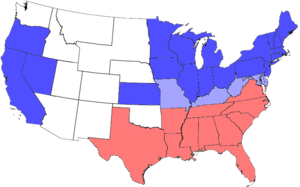
The United States 1864
Union States without slavery
Union States with slavery
Confederate States
The War of Secession, or American Civil War, was the military conflict that lasted from 1861 to 1865 between the Southern states that left the United States and united in the Confederacy and the Northern states (Union states) that remained in the Union.
The cause was a deep economic, social and political division between the northern and southern states, which was particularly evident in the slavery issue and had been deepening since around 1830. In response to the election of the moderate anti-slavery leader Abraham Lincoln as U.S. president, most Southern states seceded from the Union in the winter of 1860/61. The war began on April 12, 1861, with the Confederate shelling of Fort Sumter. It essentially ended with the surrender of the Confederate Northern Virginia Army at Appomattox Court House on April 9, 1865, with the last Confederate troops surrendering in Indian Territory on June 23, 1865. After the Northern victory, the Southern states were readmitted to the Union under Reconstruction.
The most important consequences of the war were the strengthening of central power and the final abolition of slavery in the USA, as well as the increased orientation of the country as an industrial state.
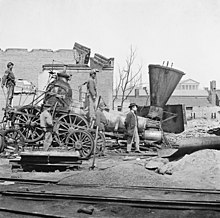
The Civil War was the first war in which railroads played a decisive role
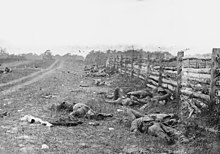
The War of Secession was one of the first wars to be documented photographically. Here: Fallen of the Battle of Antietam, photo by Alexander Gardner, 1862.
Overview
The War of Secession consolidated and unified the United States and paved the way for its rise to great power status. Because of its total character and numerous technical innovations on the battlefield, it is considered to be the first modern, industrially fought battle in history. It was the most costly conflict ever fought on U.S. soil, claiming more American lives than any other war the country has been involved in throughout its history. The Civil War is still present in the collective memory of Americans today, especially in the Southern states, on whose territory the fighting was almost exclusively fought.
At the beginning of the war, neither side was clear about how long the war would last and with what means and strategies it would be fought. Only after the first battle at Manassas, victorious for the South, did the North begin in earnest to raise and equip a powerful army. Northern leaders had become aware that the war would not end quickly.
After the battle, the South made efforts to integrate the border states of Kentucky and Missouri into its territory politically and militarily. These efforts were discontinued without result at the end of 1862.
In the East, the Union first attempted to take the Confederate capital of Richmond, Virginia with the Peninsula Campaign. However, this failed due to Confederate General Robert E. Lee. He used his success at the Seven Days' Battle and his victory at the Second Battle of Manassas to invade Maryland with his Northern Virginia Army. This first invasion of the North ended with the Battle of Antietam. After this battle, Lincoln issued the Emancipation Proclamation, declaring all slaves in the rebelling states free as of January 1, 1863, but not those in the slave states remaining with the Union. Nevertheless, the moral advantage this gave the North made it impossible for Britain and France to intervene in favor of the South. Lincoln's primary wartime goal, however, remained the restoration of the Union.
The Northern states occupied half of Tennessee in 1863 and captured the transportation hub of Vicksburg, Mississippi. This divided the Confederacy, as the Union controlled the entire course of the Mississippi River. In the East, General Lee achieved some spectacular successes in the spring. To force the Union to withdraw siege troops from Vicksburg, establish a military stalemate, and wring a negotiated peace from the North, he used his victories to re-invade Maryland and Pennsylvania. This second invasion attempt on Northern territory failed at the Battle of Gettysburg. The Confederate defeats at Vicksburg and Gettysburg in July 1863 are considered turning points in the war. By year's end, the front line ran east along the Rappahannock River in Virginia; to the west, Tennessee was divided and the Mississippi River was firmly in Northern hands. The conquest of the Mississippi Valley had already begun in 1862 with the capture of New Orleans, Louisiana and Fort Donelson, Tennessee. The blockade of Southern ports by the Northern fleet began to have an impact on industry and supplies.
President Lincoln appointed General Ulysses S. Grant, the victor at Vicksburg, commander in chief of the U.S. Army in 1864. Grant went on the offensive in both the eastern and western theaters of war simultaneously. The campaign in the east, led by himself, ended with heavy casualties and no definite result in the war of position before Petersburg, Virginia. The Atlanta campaign in the West, commanded by General William T. Sherman, finally resulted in the victory much needed for Lincoln's re-election, the capture of Atlanta. Sherman's subsequent march to the sea, across Georgia and into the Carolinas, again divided the Confederacy and now threatened Virginia, with its capital at Richmond, from the south.
The Confederates made another desperate effort to stave off total defeat in 1865, but the economic resources to supply the army and the population were exhausted - not least because of the warfare of General Sherman, who was considered a proponent of total war. The Southern states' most powerful army, the Army of Northern Virginia under General Lee, surrendered to Grant's forces at Appomattox Court House on April 9. The remaining Southern armies also laid down their arms by summer.
The end of the war was followed by Reconstruction and the reintegration of the Southern states into the Union, the "Reconstruction", which ended in 1877. Furthermore, the 13th Amendment to the Constitution, which went into effect on December 18, 1865, finally abolished slavery throughout the Confederacy. In the long run, the Civil War had the effect that the Northern states now also assumed the leading role within the Union culturally. The United States increasingly transformed itself into a centrally governed, industrially dominated federal state and laid the foundations for the economic boom of the Gilded Age and its position of world power in the 20th century.
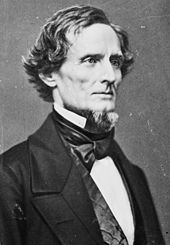
Jefferson Davis, President of the Confederate States...
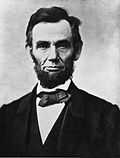
Abraham Lincoln, then President of the United States...
Causes
Political reasons
The opposition dates back to the founding of the United States. Slavery was protected by the Constitution where it already existed. In addition, the Constitution counted slaves as three-fifths of the population when measuring seats in the House of Representatives and Electoral College. Since only adult white males were eligible to vote, the Southern states thus received a voting weight well above their relevant share of the population.
The difficult balance of the two sides was always in jeopardy when a new state joined the Union. When Missouri and Maine were to be admitted to the Union in 1820, the House agreed on the Missouri Compromise. According to this compromise, slavery was to be permitted in all new states south of the Missouri Compromise line, but prohibited on principle north of it, with the exception of Missouri. For the areas east of the Mississippi, the division into northern and southern states on both sides of the Mason-Dixon line continued to apply. Thomas Jefferson feared that the division of the country by the Missouri Compromise Line could lead to the destruction of the Union.
... this momentous question, like a fire bell in the night, awakened and filled me with terror. I considered it at once as the knell of the Union.
"...This momentous question alarmed and frightened me like a fire bell in the night. It immediately occurred to me that it was the Union death knell."
The balance established by the Missouri Compromise was again put in jeopardy by the great territorial gains made by the United States in the Mexican-American War of 1848. California joined the Union in 1850 as a state without slavery (free state). This not only gave the non-slavery states a majority of 32 to 30 in the Senate, but also put a stop to the extension of slavery to the Pacific. In the Compromise of 1850, Senator Henry Clay of Kentucky struck another balance: slavery was to be permitted in the remaining territory that Mexico had ceded to Hidalgo in the Treaty of Guadalupe (the later states of New Mexico and Arizona). Moreover, the Fugitive Slave Act required the authorities of the northern states to transfer runaway slaves to the South. In turn, the slave trade was banned in the District of Columbia.
The conflict came to a head again when it became foreseeable that only Florida in the South, but three other states in the North, would join the Union. When the majority of Congress repealed the Missouri Compromise with the Kansas-Nebraska Act in 1854, the conflict escalated. Increasingly, events occurred that polarized the nation into North and South. Chief among these were the open Civil War in Kansas, the Supreme Court's sensational Dred Scott ruling in 1857 that blacks had no "rights that white men ought to respect," and abolitionist John Brown's attempt to spark a slave revolt in 1859 by raiding an Army depot at Harpers Ferry. The question of whether slavery should be permitted in principle for economic reasons or abolished in the long term for moral-religious reasons provided a permanent and increasing source of conflict.
From the Southern perspective, however, the conflict was not only about the slavery issue, but more generally about the rights of the individual states vis-à-vis the federal government. Advocates of secession argued that the individual states had not relinquished their sovereignty by joining the Union and could therefore leave the United States again at any time. Moreover, they argued, the Union could not impose a particular social system on any individual state. An individual state therefore had the right to nullify a federal law on its territory that was contrary to its interests (nullification doctrine). Had this not been true at the founding of the Union, which explicitly guaranteed property rights to slaves in the Constitution of 1787, the Southern states, it was now said, would never have joined it. Accordingly, in the opinion of the Southern States, the Northern States, by attacking slavery and otherwise interfering with the laws of the individual States, were continually violating the spirit of the Constitution and thus endangering the existence of the Union. For if the Confederacy refused the nullification doctrine, the state's legitimate recourse would be secession. Historians such as James M. McPherson, however, point out that slavery was closely tied to the "states' rights" argument: states' rights had always been much more a means to an end than an actual principle, and since the end of nullification that end had been primarily the preservation of slavery. Similarly, Brian Holden Reid states: "Without the problem of serfdom [...] there would have been no war. [...] The emphasis in the South on "states' rights" was essentially just a coded expression for the defense of slavery."
Unionists in the northern states countered the advocates of the doctrine of nullification by arguing that a democratic polity could only exist if the principle of majority rule applied: the minority was not entitled to withdraw its loyalty to the polity in the event of a decision made democratically that was not in its favour. For such a procedure would ultimately make democracy impossible, since the minority could in this way always refuse to accept the will of the majority and threaten to secede. Such a right to secession therefore did not exist in a democracy. By threatening to secede from the United States if slavery were to be restricted or if a US president they did not like were to be elected, the Southern states therefore endangered American democracy as such. This idea also underlay Lincoln's famous Gettysburg Address, in which, two years after the outbreak of war, he demanded "that the government of the people, by the people, and for the people, should not perish from the earth."
As the Southerners and secessionists placed sovereignty with the individual states, while the Unionists in the North placed it at the federal level, it became clear that there was disagreement about the character of the USA: was it more of a confederation of states from which one could withdraw, or a federal state where this was not possible? It was not until the outcome of the War of Secession that this dispute was decided in favor of the unionists and defined the USA as a federal state.
In fact, there was no majority in the Northern states for the abolition of slavery. Abolitionists remained in the minority even during the war. The Unionist politicians of the North therefore officially always took the position that it was not about slavery, but about democracy and the preservation of the United States. Even Abraham Lincoln, the presidential candidate of the Republican Party for the election year 1860, did not advocate the immediate abolition of slavery, but only its consequent restriction to the states where it already existed. How far polarization had already progressed at that time is shown by the fact that Lincoln was not even on the ballot in ten Southern states.
Both sides later denied that the slavery issue had been the reason for the outbreak of the Civil War. However, it had been a major factor in the development of different economic and social systems in the North and South, which then led to political and economic disputes.
Economic and social reasons
While industrialization and with it the steep rise in the productivity of wage labor progressed in the Northern states, the focus of the Southern states' economy, especially that of the Deep South, remained on the production of cheap raw materials, where price pressure favored the cheaper slavery compared to wage labor. Thus, the North offered immigrants better working conditions, and the labor shortage that was generally prevalent at the time became more acute in the South. This was accompanied by the South's dependence on slavery.
A long-standing point of contention between North and South was the protective tariff policy of the Confederation, which had led, among other things, to the largest constitutional crisis to date, the Nullification Crisis of 1832/33. In some Northern states, as a result of the economic crisis of 1857, the conviction reasserted itself that higher protective tariffs could help the domestic economy weather the crisis. This desire for a renewed protective tariff policy found expression in the Republican party platform. The protective tariffs were primarily intended to make cheap imports of foreign industrial goods more expensive and thus improve sales of industrial goods produced in the North. The agrarian South, however, hardly produced any industrial goods, but had to import them either from abroad or from the North. Therefore, a price increase caused by the protective tariffs would have hit the Southern economy hard. In addition, the South produced nearly two-thirds of all exports in 1860 and feared that its markets would impose the same kind of tariffs. Despite these conflicting economic interests, the North and South depended on each other for continued economic growth. What the South did not export went to the North, which supplied the South's residents with the products of industrial production.
Different societies had developed in the North and South: The bulk of the population of the northern states consisted of small farmers in the west and wage laborers in the east. In addition, there was a small middle class as well as a few old-timers and the newly rich in the upper class. The public education system was well developed, since skilled working people were needed in industry. However, only the privileged had access to higher education.
The South was home to impoverished white day laborers and farmers, a small middle class of artisans and small plantation owners with few slaves, and a small, long-established upper class of large plantation owners. The public education system remained rudimentary, but members of the upper class were well educated in private schools. Despite the enormous disparity in wealth, there was little tension within the white society of the South. The guiding image of the planter aristocrat and the opposing image of the slave, who because of the color of his skin - no matter how low the individual white man had sunk - was fundamentally far below a white man (white supremacy), left Southerners almost united behind the institution of slavery.
A factor not to be underestimated was also the fear of the whites of a freed slave population. "The horrors of Santo Domingo", where after the revolution in Haiti in 1804 between 3000 and 5000 members of the French colonial power were killed by former slaves, was still remembered by older people and was also invoked again and again.
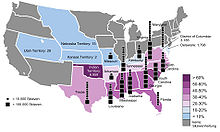
Percentage of slaves in the total population in each American state and territory in 1860.

The Marais des Cygnes Massacre, perpetrated in Kansas on May 19, 1858, by supporters of slavery against their opponents.
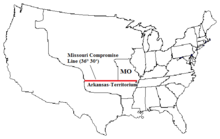
The Missouri Compromise Line
Questions and Answers
Q: What was the main cause of the American Civil War?
A: The main cause of the American Civil War was slavery, which was allowed in the South, including all 11 Confederate States. Slavery was illegal in most of the North.
Q: When did the war begin?
A: The war began on April 12, 1861 when Confederate forces attacked Fort Sumter, a fort in South Carolina that was held by Union soldiers.
Q: How long did it last?
A: The war lasted four years.
Q: Where were most battles fought?
A: Most battles were fought in northern states until 1862 and then in southern states after 1862.
Q: Who won the war?
A: The Union won the war.
Q: What happened after the Union won?
A: After the Union won, slavery was made illegal everywhere in the United States of America.
Search within the encyclopedia